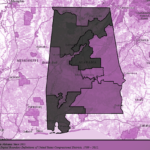This is the third article of a 10 part series on redistricting + apportionment + gerrymandering, in relation to Alabama.
In a representative democracy, we citizens elect people to represent us in various governmental bodies. But consider the difference between electing somebody to represent 10 people, versus 10,000 people. In the case of the U.S. Senate, it’s already set: The entire population of a given state elects two senators. For Alabama, that means that each of us is one of about 3.5 million registered voters eligible to cast a vote for each senator (out of a state population of 5 million). The House of Representatives, in contrast, has had to deal with the steady increase in the population of the United States since the founding. Keeping the population size of the federal Congressional districts small would eventually result in an unmanageable number of representatives, or at least that was the rationale in 1929, when legislation capped the number of representatives at 435 with the “Permanent Reapportionment Act.” That, of course, means that the average number of people for each representative has steadily increased. Currently it is about 711,000 people per federal Congressional district for the House of Representatives.
There was concern that changes in Alabama’s population between 2010 and 2020 might result in our losing a federal Congressional district, going from 7 to 6, but that is not the case. When the detailed official Census data for 2020 is released on August 16th of 2021, it will be the role of a committee of the Alabama legislature, the “Permanent Committee on Reapportionment,” to adjust the Congressional districts within the state to be approximately equal in population.
The 2016 Code of Alabama, Title 29 – LEGISLATURE, Chapter 2 – PERMANENT LEGISLATIVE COMMITTEES, Article 4 – Committee on Reapportionment states that the purpose of the committee is “to prepare for and develop a reapportionment plan for the state.” In terms of membership in the years when the census data is released, “the committee shall be composed of 22 members as follows: One member of the House of Representatives from each Congressional district, four members of the House of Representatives at-large to be appointed by the Speaker of the House and one member of the Senate from each Congressional district, four members of the Senate at-large, to be appointed by the Lieutenant Governor.” The statute also indicates that the committee will have access to various resources, and that the committee “may” hold public hearings. The current membership of the committee is 6 Democrats and 15 Republicans.
If you would like to read about the history of redistricting in Alabama (and incidentally learn that the legislature failed to comply with Alabama Constitution of 1901 in terms of state legislative districts from 1901 to 1972) and the creation of the Permanent Legislative Committee on Reapportionment, check out their history page.
Note the confusion in terminology (also noted on the history page): “reapportionment” is what Congress does in taking the census data and dividing by 435 to determine how many federal Congressional districts there will be in each state. “Redistricting” is what the state does in drawing the map of the allocated federal Congressional districts to achieve as close to an equal number of people as possible in each district. The term “redistricting” also applies to all state-level districts for the Alabama legislature, county commissions, city councils, etc.
This series is a joint effort of the blog editor, Catherine Davies, and other members of the Advocacy Team and Board of the League of Women Voters of Alabama.

